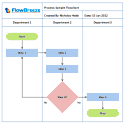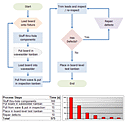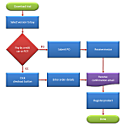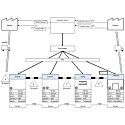The Top 5 Reasons To Use Flowcharts
By Nicholas Hebb
Sometimes it's more effective to visualize something graphically that it is to describe it with words. That is the essence of what flowcharts do for you. Flowcharts explain a process clearly through symbols and text. Moreover, flowcharts give you the gist of the process flow in a single glance. The following are some of the more salient reasons to use flowcharts.
Excel Flowchart Wizard
FlowBreeze is a flowchart add-in for Microsoft Excel that makes creating flowcharts simple and pain free. Free 30-Day Trial.Process Documentation / Training Materials
Another common use for flowcharts is to create process documentation. Although this reason overlaps with regulatory and quality management requirements (below), many non-regulated businesses use flowcharts for their documentation as well. These can range in form from high-level procedures to low-level, detailed work instructions.
You may think that this applies mainly to large organizations, but small companies can greatly benefit from flowcharting their processes as well. Small enterprises need to be nimble and organized. Standardizing their processes is a great way to achieve this. In fact, the popular entrepreneurial book The E-Myth Revisited: Why Most Small Businesses Don't Work and What to Do About It by Michael Gerber is based on the fact that small businesses are more likely to succeed if they treat their operations like a franchise. in a nutshell, this means standardizing and documenting their business processes. There's no better way to do that than with flowcharts, right?
Training materials are often created using flowcharts because they're visually stimulating and easy to understand. A nicely laid out flowchart will gain and hold the reader's attention when a block of text will often fail.
Workflow Management and Continuous Improvement
Workflows don't manage themselves. To ensure that you are meeting your customers' needs, you need to take control of your business processes. The first step to workflow management is to define the current state of your processes by creating an "As-Is Flowchart". That allows you to analyze your processes for waste and inefficiency. After you have identified areas for process improvement, you can then craft new flowcharts to document the leaner processes.
Programming
Information technology played a big influence on the use and spread of flowcharts in the 20th century. While Dr. W. Edwards Deming was advocating their use in quality management, professionals in the data processing world were using them to flesh out their programming logic. Flowcharts were a mainstay of procedural programming, however, and with the advent of object oriented programming and various modeling tools, the use of flowcharts for programming is no longer as commonplace as it once was.
That said, even with in the scope of object oriented programming, complex program logic can be modeled effectively using a flowchart. Moreover, diagramming the user's experience as they navigate through a program is a valuable prerequisite prior to designing the user interface. So flowcharts still have their place in the world of programming.
Troubleshooting Guides
Most of us have come across a troubleshooting flowchart at one time or another. These are usually in the form of Decision Trees that progressively narrow the range of possible solutions based on a series of criteria. The effectiveness of these types of flowcharts depends on how neatly the range of problems and solutions can fit into a simple True/False diagnosis model. A well done troubleshooting flowcharts can cut the problem solving time greatly.
Regulatory and Quality Management Requirements
Your business processes may be subject to regulatory requirements such as Sarbanes-Oxley (SOX), which requires that your accounting procedures be clearly defined and documented. An easy way to do this is to create accounting flowcharts for all your accounting processes.
Similarly, your organization may fall under certification requirements for quality management systems - such as ISO 9000, TS 16949, or one of the many others. In such environments, flowcharts are not only useful but in certain clauses they are actually mandated.
About the Author
Nicholas Hebb
Nicholas Hebb is the owner and developer of BreezeTree Software, makers of FlowBreeze Flowchart Software, a text-to-flowchart maker, and Spreadspeed, an auditing and productivity toolset for Microsoft Excel®.



